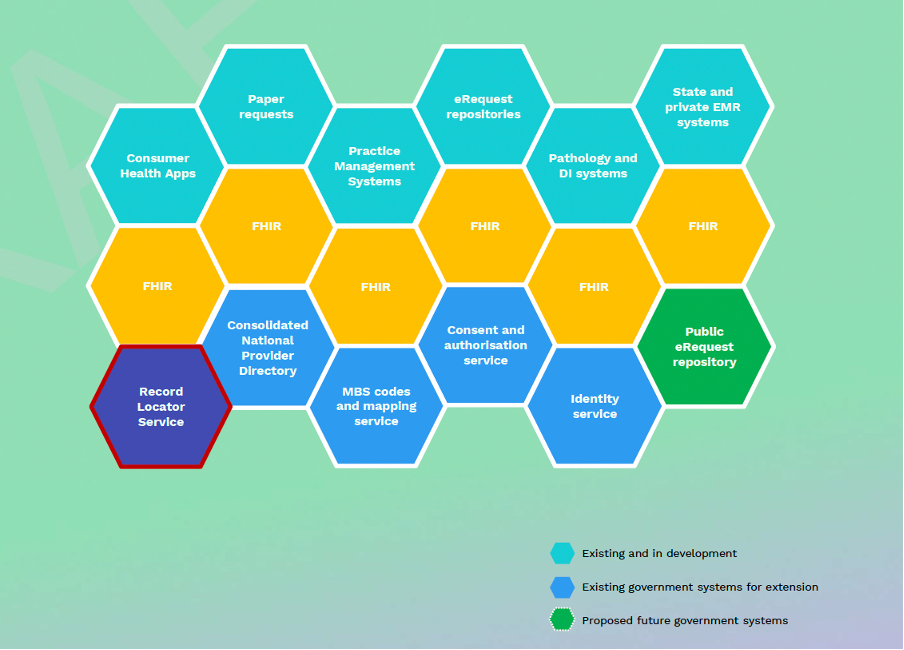Pathology providers have always been paid properly, but in this vision, they are going to be paid a lot less. Time to rethink business models.
Earlier this month the Department of Health and Aged Care released what it is calling an eRequesting Long Term Target State Hypothesis which, roughly translated, means a very early version of the department’s vision for eRequesting between providers for things like ordering pathology for a patient.
The document is a lot more than just a vision of eRequesting. It’s an outline of the first-use case of a much bigger interoperability vision for the whole country’s health system, based on what the government now thinks will be some form of nationally connected information health exchange (IHE).
The summary version of the vision is here.
Every medical technology vendor (especially practice management software vendors), and providers (especially pathology, imaging, hospitals, GPs and specialists), should have a quick go at reading through the document to get a sense of what the DoHAC is really thinking, is now likely to attempt and how such changes might eventually affect them.
The paper is clear in identifying all the parts of the system that the DoHAC wants to align through a series of new interoperability infrastructure initiatives and how they’d like it all to work together.
It identifies what the government thinks they will need to do to make it all come together – a record locator service, a national provider directory, MBS codes and mapping services, and a consent and identity service. It also provides a few interesting examples of how these pieces of infrastructure are likely to interact with providers, patients and the technology platforms servicing them.
It is put in its most simplistic way in the diagram below. Note the magical FHIR in yellow connecting all the provider and patient tech with the relevant government infrastructure.

Most vendors (pathology providers and patient management system vendors in particular) should already be familiar with this document. But for the average punter, doctor or patient trying to understand all this, one way to think about what the government is attempting here is another version of how eScripts have ended up working.
If everything in this document one day works the way this vision is laid out then as a patient you might go to your doctor, the doctor thinks you need a pathology test so sends your phone or app a token, and you can take your phone anywhere to get that request filled.
When you do, the information will go back to you, the patient and your doctor. Your doctor will also be able to add information in the token request which seeks out other relevant information from the system and adds it to the transaction, after getting consent from the patient.
This process mostly works via paper forms handed out to patients currently, which is convenient for pathology providers, because it tends to channel patients to their businesses via the form.
From a consumer point of view, such a service will be nice to have, but from a pathology provider point of view, it’s the beginning of breaking down a long-established model of channelling patients exactly where they want them to go.
If you take this concept and widen it to all relevant health data that providers might like to share between each other to help a patient (referrals, hospital patient summaries, pathology results going back to doctors, looping in relevant allied health professionals) and throw in tracking all those data transactions for faster and more accurate MBS payments, you have something of the eventual vision, which no one should be objecting to.
We probably won’t be seeing any public objection other than around timing and capital outlay required by relevant vendors, especially by small to mid-sized local software vendors.
The development work required for all of this to work – re-engineering existing platforms to cloud-based architectures, smart workarounds like Halo Connect – is significant and expensive.
The Medical Software Industry Association has already arced up significantly on behalf of its members about the timetable for pathology and imaging groups to be uploading all of their results in near real-time to the My Health Record, because a lot of work is going to be required by the smaller pathology providers and some by the patient management platforms for this to happen.
Shootout at the pathology provider corral
If there is a bombshell in this seemingly inane document for anyone it is in the very first point explaining the value of the eRequesting project: to reduce duplication of diagnostic services.
The paper states:
“Studies from the UK’s NHS indicate that up to a quarter of all pathology requests may be duplicates or unnecessary. eRequesting has the potential to dramatically reduce over-requesting and improve the selection of appropriate services. This will drive down MBS spend, reduce consumer burden and free up time for clinicians.”
All of this makes complete sense.
But imagine reading that if you’re the CEO of one of the major pathology and imaging companies. Translation: we’re aiming to drop your volume of testing and, through that, revenue generated by that activity by quite a lot.
Overall, that might be a hit to overall revenue of a pathology group of upwards of 10-15%.
This looks like a battle the government has thought a lot about and is prepared to have, but it feels like at some point it’s not going to be pretty.
Real reform is hard. The major pathology companies have been making massive profits for many years now and cleaned up especially through covid.
But if this program is successful in achieving this goal, the pathology companies are going to have think very hard about how they make their money in what is obviously a very new and different paradigm in which there is significantly less chaos in the buying chain, and where they are going to find it much harder to control their referral channels to patients.
Sonic – which doesn’t only do pathology, and which has a significant overseas footprint, so the following may not be an entirely valid figure to quote – made a profit of $685 million on revenues of $8.2 billion in 2023, which is a margin of 8.3%.
But here’s the thing.
How do you argue with the logic the DoHAC provides in the paper to improve the system in the manner it is proposing?
Other reasons it gives for its eRequesting program include driving consumer choice and transparency, improving communication and therefore efficiency and safety via better provider-to-provider communication and better government visibility over important data for developing population health strategies and health policy.
Who is going to front up and say, “yeah, but that does not suit my old business model because if you do it I’m likely to make a lot less money or even go broke”?
It might be true, but this is real reform that makes complete sense for all parties bar those that were profiting off a fragmented and disorganised system.
No one is likely to front up and argue the “but I can’t make as much money” line, but most will now hunker down and look at some combination of political resistance, commercial resistance and, hopefully, look at their business model and start working on making money in the new world in some way.
What all the groups likely to be affected have is time.
This is a vision paper and a paper of intent but between the vision and a working model there is a lot of work to be done, especially by the government, which in this paper has given itself a massive amount of infrastructure work to do – record location, provider directory, new MBS coding, consent and identity.
One short-term effect of this paper might be around the current system of pathology rents at co-located GP and specialist practices.
Currently there are about 8000 smaller pathology services co-located with medical practices, the idea being that given a patient can go anywhere they like to get their pathology done, why would they if they can walk through the pathology lab on the way out.
It is not legal for a doctor to channel a patient to any particular pathology provider, even though in most practices you get given a pathology request form with the address and branding of only one provider on it, and most patients think that is where they have to go.
That is one form of surreptitious channelling. But the most overt, but still legal, form is to locate your pathology lab within a doctor’s practice for convenience.
Pathology rents are the second largest form of income for most medical practices.
If eRequesting is going to end up like eScripts, and patients will simply have a token they can take anywhere, co-location becomes even more valuable in holding onto your channel.
It theoretically should drive up the value of pathology rents, which might be a good thing for GPs at least.
A mobile token system like eScripts for pathology requesting. combined with the significant increase in volume of telehealth post-covid. and the continued rise of major telehealth platform providers like Instant Scripts and Hub Health, are going to represent more challenges for the pathology groups, who theoretically will have no ability to channel the request to their group, just as chemists have no ability to channel a script request.
All the major pathology providers are reporting significantly decreased revenues post-covid as a result of reduced foot traffic through GP practices where they have labs co-located. This trend will only get worse as bulk billing declines, as it slowly will over time.
In a normal business situation a group would likely just shrug its shoulders here and put the prices up for its services – tests, in the case of pathology labs.
But most of the volume the pathology providers process is paid for by the MBS and given the government has tightly screwed down the MBS for GP rebates, it would not be a good look for it to turn around and start letting the pathology labs bring in big increases to test items.
GPs have had to adapt rapidly and creatively to a system that stopped paying them properly.
Pathology providers have always been paid properly, but in this vision, they are going to be paid a lot less, so they are going to have the similar problem, albeit at massive scale.
And like GPs they are going to need to get more efficient and creative in how they run their businesses.
There is a lot more in this paper, including how the big patient management system providers are likely going to have to adapt. We will discuss that in another article next week.



